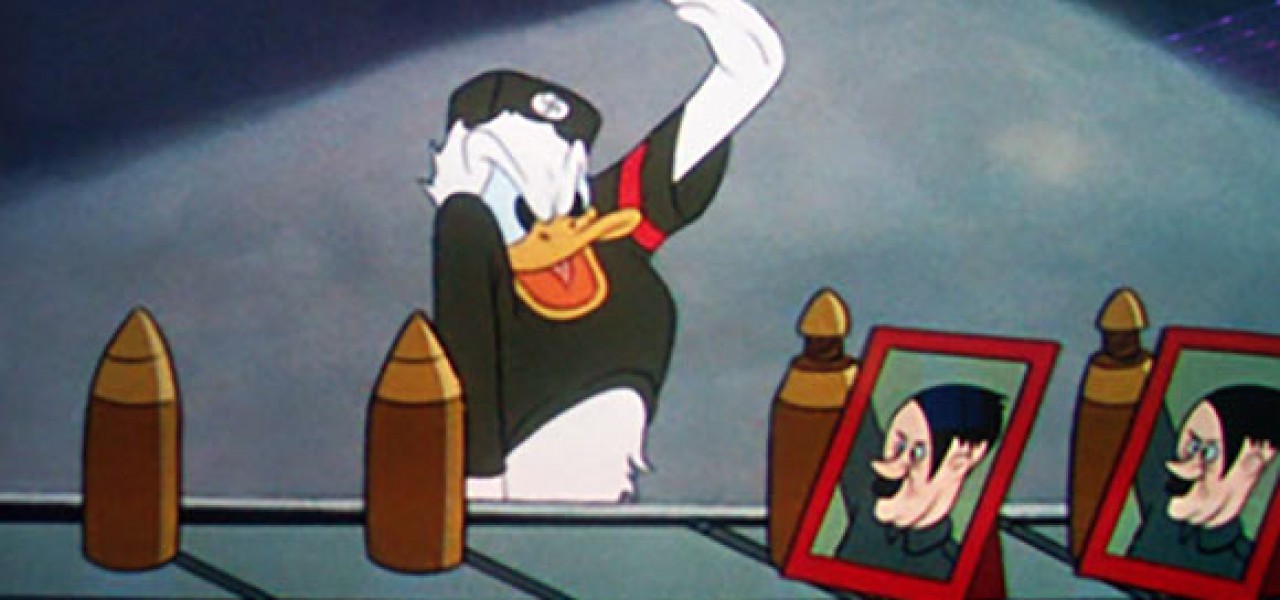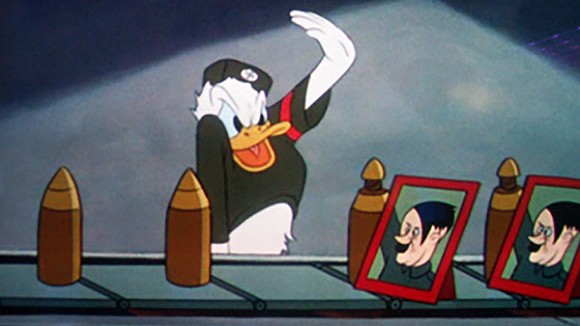

Book Reviews: Disney in the Time of World War II

The Disney Studio During World War II
by John Baxter
(Disney Editions, 182 pages, pub. date November 2014)
Buy: $26.89 on Amazon
Service with Character: The Disney Studio & World War II
by David Lesjak
(Theme Park Press, 254 pages, pub. date May 2014)
Buy: $17.95 on Amazon
Shortly after December 7, 1941, the infamous day of Japan’s attack on Pearl Harbor, the U.S. Army moved hundreds of its personnel onto the Disney lot, taking over several buildings. Suddenly the war was not just on the horizon—it was on the Disney lot.
Throughout the U.S. war effort, Walt Disney saw to it that the studio did its part, fully cooperating with government, but also initiating its own patriotic film projects to boost public morale, most notably its 1943 animated film of Major Alexander de Seversky’s book Victory Through Air Power.
It was a tough time for the studio. The war in Europe was cutting off foreign markets for their films; Pinocchio and Fantasia had underperformed at the box office; and a strike had impaired relations between Walt and his staff.
Two books published last year examine Disney in this period. The Disney-sanctioned The Disney Studio During World War II, by John Baxter and published by Disney Editions, and the independently researched Service with Character: The Disney Studio & World War II by David Lesjak, a revision of his 2000 book Toons At War.

The military moving into Disney’s studios provides a clue as to what to expect from the two books: Baxter mentions the incident in passing; Lesjak tells the whole story. Whereas Baxter supplies the official history and an overview of the studio’s output at the time, Lesjak, with a genuine historian’s touch, reveals more about the personalities and delves more deeply, and more satisfyingly, into individual projects.
Lesjak, who has been writing about the Disney Studio since the 1980s, shows the extent of his homework on every page. Quotes from individuals, newspapers, trade publications and elsewhere abound. While Baxter reproduces an image of a savings bond certificate with no further explanation, Lesjak provides the necessary context, exploring in detail the Bonds for Babies program that made extensive use of that certificate.
Both books offer more insights than other casual histories. Baxter reveals, for example, the important role played in the time by Ub Iwerks, whose work at Disney after he returned to the studio in 1940 is seldom written about. As it turns out, Iwerks was executive producer, and sometimes director, of several of Disney’s animated military training films, and did the legwork for the studio’s very first war-related short, The Thrifty Pig (1941), which pitted Disney’s Three Little Pigs against a Nazi Wolf.

Less well-known Disney staffers populate both books too. Baxter and Lesjak are full of praise for Disney artist Hank Porter, described by Walt as a “one-man art department,” who designed around 1,300 insignias for units in all branches of service, and Lesjak reproduces the somewhat less well-known nude pinups by Freddie Moore, Bill Justice, and Milt Kahl, which were included in Dispatch from Disney’s, a one-issue newsletter from 1943 aimed at Disney staff at home and in the armed forces—perhaps the only nudes of this kind issued under the studio’s imprimatur. Of course, they are tame, even by the standards of the day, though Freddie Moore’s drawing, showing a little girl and a young woman in towels, might raise eyebrows today.

The color reproductions in The Disney Studio During World War II are plentiful and illuminating: the storyboards for Disney’s aborted Gremlins film, from a Roald Dahl story, are particularly valuable. Theme Park Press, however, has made an unusual choice with Service With Character: though the e-book includes the illustrations with the text, the paperback edition includes only a list of images that are viewable on the book’s website. A lack of an index in Lesjak’s book is the other frustrating drawback.
Even with the lack of index, Lesjak’s Service With Character is the more rounded and comprehensive text, more useful to the animation scholar, and more likely to hold up to regular reading. Baxter’s The Disney Studio During World War II will look prettier on your coffee table.

